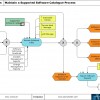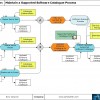Process of the Month – Maintain a Supported Software Catalogue Process
This is one of those “fly-wheel” processes in SAM that doesn’t often exist, but can seriously punch above its own weight. Maintaining a Supported Software Catalogue takes SAM audit and reconciliation data beyond pure SAM boundaries, and can feed Business Intelligence back into the company via the Service Desk function.
Maintain a Supported Software Catalogue Process
Primary Objective:
- To annually review and categorise the software titles in the Supported Software Catalogue
Secondary Objectives:
- To ensure that this process runs at least once, annually.
- To capture and review requests for software titles that are not currently in the Supported Software Catalogue
Assumption:
- That a Supported Software Catalogue exists. If a Supported Software Catalogue doesn’t exist, then take an inventory report of your IT estate and use that as your foundation. Clearly the first time this process is run, there will be much wailing and gnashing of teeth over the volume of software titles to be reviewed – but it will get better the more frequently this process is run. It might also be prudent to wash your inventory report through your SAM suite so that you are reviewing bona fide software titles rather than every known executable your inventory system can find.
- Screenshot A
- Screenshot B
Function Step Overview:
| 1.10 | The trigger for this process is typically a marker in a diary to say a review needs to take place; depending upon the size of your software estate this process might better serve your staff if it divides up your software estate over the course of 12 months. It could also be that a software request comes in that is not for a title on your supported software catalogue – this too should kick-start the process (albeit for that title only).Further processes (such as the Software Testing Process, the preferred channel through which software titles should arrive for assessment) and the Software Rationalisation process, could also initiate a review/update of status for a software title (more on this next month).At this point, The Service desk Manager, SAM Manager and any interested parties will review the titles with a view to categorising them either “Red” (title is to be retired, and not offered for installation to end users) “Amber” (title is to remain supported and on the network, but a preferred title is currently in place) and “Green” (the preferred supported software title)
Advice and guidance on the status of software titles might come from the following sources:
These are just suggestions, many other factors could be brought to bear such as business strategy documents (which might require new technologies to be considered).
On those software requests where a software title is being requested that might fall under the category of “Other” (i.e. completely new to the IT environment/IT Dept) then the process has been modelled to allow for that title to be considered to be added to the Supported Software Catalogue. If such a request hasn’t gone through proper channels (how does that happen?!) then the request can be rejected stating the reason why (e.g. the title hasn’t been tested, or perhaps it hasn’t been packaged, or it could be that the title has already been ear-marked as “Red”)
Finally, the review process can address those titles that have gone through more formal channels and have successfully completed the testing process.
The interested parties can vary from one software title to the next, and as stated before this could support sequencing the running of this process more than once in a year – what business/interest would an Oracle Architect have over deciding the status-setting of Adobe Creative Suite? (as an example) |
| 1.20 | The SAM Manager (and interested parties) have decided that a software request does not meet the accepted criteria and so is returned to the requestee with the reason(s) why. |
1.30 |
Subject to the review at 1.10, a software title has had its status changed to “Red” – this provides us with our first use of the circular “AND” symbol of the series, as staff are required to follow on to step 1.60 and to also ear-mark the title for removal via the Software Removal Process. One aspect to consider when ear-marking a title for Red status is that of dependencies: Will other software titles cease to function once a title is removed? This is where the role of Product Champion comes into its own; they will be best placed to make such a call |
| 1.40 | Subject to the review at 1.10, a software title has had its status changed to “Amber” |
| 1.50 | Subject to the review at 1.10, a software title has had its status changed to “Green” |
| 1.60 | The SAM Manager publishes the revised Supported Software Catalogue |
Communication of those changes to the Supported Software Catalogue can either be left to users finding those changes on whichever portal/information site the company chooses (not recommended – too passive) or the SAM Manager could take the time to devise a Communications Strategy to inform users at the earliest opportunity that some titles are being removed so as to lessen any culture shock, and facilitate any up-skilling that might be required when users move to a newer version/title.
It is also recommended that the published list to end users is ONLY comprised of software categorised as Green.
Other Process of the Month Articles:
The process kit by Rory Canavan is available from SAMcharter.com
Related articles:
Software Ownership: Who should ‘Own’ software licenses within an organisation?
We're getting worse at SaaS Management, 37% of spend is wasted
Excellence Awards Profile: SAM at Roche; Think big, start small
Process Template: Software Authorization and Procurement
Software Licensing Challenges Faced In The Cloud: How Can The Cloud Benefit You?
Process of the Month – Software Re-harvesting Process
- Tags: Business Intelligence · Oracle · Process of the Month · SAM
About Rory Canavan
With a technical background in business and systems analysis, Rory has a wide range of first-hand experience advising numerous companies and organisations on the best practices and principles pertaining to software asset management.
This experience has been gained in both military and civil organisations, including the Royal Navy, Compaq, HP, the Federation Against Software Theft (FAST) and several software vendors



Do you have guidelines on how Software Testing Process should look like?